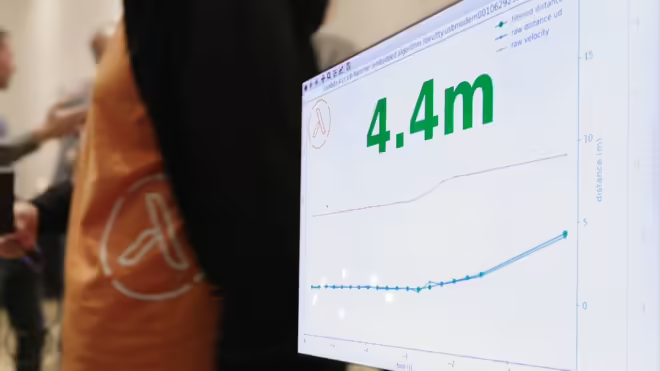
Bluetooth® Channel Sounding is a new secure, fine-ranging capability that promises to enhance the convenience, safety, and security of many Bluetooth connected devices. From increasing the security of digital keys to improving the performance of Find My solutions, Bluetooth® Channel Sounding will enhance our connection with our devices, one another, and the world around us.
“Extending an already rich ecosystem, the Bluetooth® Channel Sounding standard enables connected devices to more precisely and securely locate each other, paving the way for the design of new low-cost, energy-efficient, location-aware solutions,” said Kyle Golsch, senior RF system engineer at DENSO. “It also has the potential to provide a more secure and convenient user experience for automotive digital key solutions and we look forward to leveraging this technology inside and outside of automotive areas to enable more seamless user experiences for all.”
How Bluetooth Channel Sounding Works
Bluetooth® Channel Sounding uses two proven ranging methods, phase-based ranging (PBR) and round-trip time (RTT), to enable secure, fine ranging between two Bluetooth connected devices.
Phased-Based Ranging (PBR) for High-Accuracy Distance Measurement: Bluetooth® Channel Sounding leverages phase-based ranging (PBR) to achieve precise distance measurements between two devices. In PBR, an initiator device sends a signal to a reflector device, which returns the signal. Once the returned signal is received, the distance between the devices is calculated based on the phase difference between the transmitted and received signals. This process is repeated across multiple frequencies to enhance the accuracy of the distance measurement.
![Channel Sounding Graphics Phase Based Ranging[1] Channel Sounding Graphics Phase Based Ranging[1]](https://www.bluetooth.com/wp-content/uploads/2024/08/Channel_Sounding_Graphics_Phase_Based_Ranging1.png)
Round-Trip Time (RTT) for Secure Distance Bounding: Bluetooth® Channel Sounding also incorporates a secondary ranging method called round-trip time (RTT) as a countermeasure against sophisticated man-in-the-middle (MITM) relay attacks. In RTT, an initiator device sends cryptographically scrambled packets to a reflector device, which returns the packets. The distance between the devices is then calculated based on the time it took for the packets to travel back and forth.
RTT acts as a secure distance bounding technique, providing an independent distance measurement to cross-check the PBR measurement, significantly reducing the risk of MITM attacks. By combining PBR and RTT, Bluetooth® Channel Sounding enables secure and accurate distance measurements between devices.
![Channel Sounding Graphics Round Trip Time[1] Channel Sounding Graphics Round Trip Time[1]](https://www.bluetooth.com/wp-content/uploads/2024/08/Channel_Sounding_Graphics_Round_Trip_Time1.png)
![]()
FEATURED PAPER
Bluetooth® Channel Sounding: A Technical Overview
This paper provides an overview of the forthcoming update to the Bluetooth® Core Specification. The update adds Bluetooth Channel Sounding, a new feature that enables secure fine ranging between two Bluetooth devices.
The Complete Suite of Bluetooth Positioning Features
With the addition of Bluetooth® Channel Sounding, the suite of Bluetooth technology positioning features now includes multiple techniques for measuring distance between two devices, along with proven methods for detecting presence and understanding direction.
Presence – It’s Nearby: Bluetooth Advertising allows a transmitting device to share its presence with scanning devices within a general area, enabling one device to detect the presence of another. Bluetooth Advertising can typically enable a device to detect the presence of another device at distances of 100m or more.

Direction – It’s That Way: Bluetooth Direction Finding enables a receiving device to determine the direction of a signal from a transmitting device. It includes two different methods for determining signal direction, angle of arrival (AoA) and angle of departure (AoD). Bluetooth Direction Finding can typically determine the direction of a signal within +/- 5 degrees.
![]()
Distance – It’s That Far Away: Bluetooth RSSI (received signal strength indication) is a coarse-ranging feature that enables a receiving device to estimate the distance to a transmitting device by measuring the power level of the received radio signal. Bluetooth RSSI can typically achieve distance estimations with meter-level accuracy.
![]()
“The adoption of Bluetooth® Channel Sounding will help the ICCOA continue to deliver greater convenience, performance, and security to drivers and passengers worldwide.”
– Feng Yunsheng, ICCOA
By adding Bluetooth® Channel Sounding as a second ranging technique, Bluetooth technology can now be used to compute the distance to another device with centimeter-level accuracy, enabling true distance awareness. Bluetooth Channel Sounding can typically achieve distance measurements with an accuracy of +/- 50cm up to 100 meters.
“We look forward to adding this new feature to our upcoming Bluetooth Digital Key specification,” said Feng, Yunsheng, chief secretary of the Intelligent Car Connectivity Open Alliance (ICCOA). “The adoption of Bluetooth® Channel Sounding will help the ICCOA continue to deliver greater convenience, performance, and security to drivers and passengers worldwide.“
With Bluetooth® Channel Sounding, developers will now be able to add true distance awareness to Bluetooth connected devices without having to design in an additional radio technology. To learn more about the intricacies of this new Bluetooth feature, check out the Bluetooth® Channel Sounding Technical Overview.
![]()
FEATURED PAPER
Bluetooth® Channel Sounding: A Technical Overview
This paper provides an overview of the forthcoming update to the Bluetooth® Core Specification. The update adds Bluetooth Channel Sounding, a new feature that enables secure fine ranging between two Bluetooth devices.



























